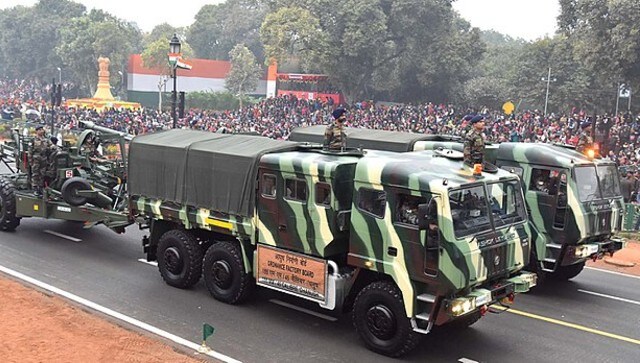Explained: Why Centre has restructured over 240-yr-old Ordnance Factory Board, and what it means for India's defence production
Inefficiencies in production and delays in delivery of orders are the primary reasons behind the restructuring of the Kolkata-based Ordnance Factory Board

Why Centre has restructured over 240-yr-old Ordnance Factory Board, and what it means for India's defence production. Image courtesy: Wikimedia Commons/PIB
After 20 years, the plan to restructure the over 240-year-old Ordnance Factory Board, which provides for much of the basic fighting needs of the Indian armed forces', was finally approved by the government on Wednesday.
So, what had held up the move to corporatise the OFB, and how will the proposed changes help the cause of improved defence production in India?
What Is The Ordnance Factory Board?
The Kolkata-based OFB presides over a group of 41 factories that specialise in production, testing, logistics, research, development and marketing of "a comprehensive product range in the area of land, sea and air systems".
The origin of the OFB can be traced back to British times when the colonialists set up the Board of Ordnance at Kolkata's Fort William in 1775. Thereafter, in 1787, a gunpowder factory was established not far from Kolkata at Ishapore, followed by the setting up of a gun carriage factory in 1801 at Cossipore, and also on the outskirts of the West Bengal capital.
At present, the 41 factories are made up of 11 ammunition and explosives factories, 10 weapons, vehicles and equipment factories, and a total of 20 material and components, armoured vehicles and ordnance equipment factories.
Why is OFB being corporatised?
The Centre has announced that these 41 factories will be bunched together under seven new companies, all of which will function as 100 percent government-owned public sector undertakings (PSUs). The Centre has said that the restructuring will help improve the accountability, efficiency and competitiveness of these factories.
In a press release in December 2019, the Ministry of Defence had noted that "during the past two decades, several high-level committees like TKA Nair Committee (2000), Vijay Kelkar Committee (2005) and Raman Puri Committee (2015) have... recommended that ordnance factories should be converted from a government department into a corporate entity".
It was in pursuit of that target that the Cabinet Committee on Security had last July approved the decision to convert OFB "into one or more than one 100 percent government-owned corporate entities, registered under the Companies Act 2013". The latest announcement is a step towards giving effect to that decision.
What will change after the govt order?
According to the plan, the 41 companies will reportedly be grouped under the new entities that will function like any other existing defence public sector undertakings (DPSUs) like Hindustan Aeronautics Ltd (HAL) or Bharat Electronics Limited (BEL).
The seven new entities will include an ammunition and explosives group, a vehicles group, a weapons and equipment group, a ‘troop comfort items group’, an ancillary group, an optoelectronics group and a parachute group.
While the key goal is to ensure a smoother and more timely meeting of domestic targets, officials said that the restructuring has also been done with an eye on stepping up India's defence exports game.
According to reports, the overhaul will be implemented by the empowered group of ministers led by Defence Minister Rajnath Singh. The restructuring is expected to be in place in this year itself.
What necessitated the restructuring?
The Comptroller and Auditor General (CAG), in the report on the ordnance factories for the year ended March 2018, noted that "production in factories continued to fall short of targets" and that the various ordnance factories "could achieve targets for only 49 percent of items in 2017-18".
The CAG added that "a significant quantity of the Army’s demand for some principal ammunition items remained outstanding as of 31 March 2018 which may adversely affect their operational preparedness".
Inefficiencies in production and delays, thus, can be deemed to be a primary reason behind the overhaul of OFB. But the proposal had not found support among the workers' unions of the factories.
In its press note on corporatisation last year, the Ministry of Defence had said that "the government has taken note of the strike by workers of OFB against the proposed corporatisation and their concerns".
In response, it said that an Empowered Group of Ministers (EGoM) had been set up under the defence minister to address issues of "transition support and redeployment plan of employees while safeguarding their wages and retirement benefits".
Announcing the restructuring plan on 16 June, Union Defence Minister Singh said there will be no change in service conditions for the nearly 70,000 OFB employees. Further, the Centre would continue to foot the pension bill for retired and existing employees.
also read

UPSC NDA/ NA II exam application process begins; apply on upsconline.nic.in by 29 June
The admit cards for UPSC NDA/ NA II exam are expected to be issued in the month of August on upsconline.nic.in as well

Defence ministry clears project to build six conventional submarines
The Make-in-India project, named P-75 India, will cost the exchequer around Rs 43,000 crore

Rajnath Singh approves budgetary support of nearly Rs 499 crore for innovations in defence sector
The funds will be used to support nearly 300 start-ups and MSMEs and innovators with the aim of ensuring self-reliance in the defence sector, an official statement said